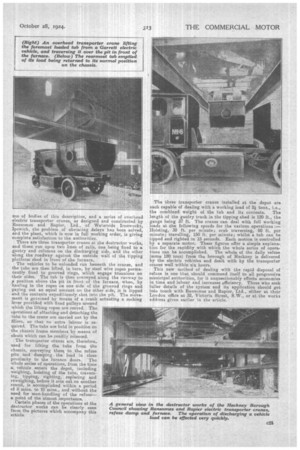TIME-SAVING IN REFUSE COLLECTION.
Page 12

Page 13

If you've noticed an error in this article please click here to report it so we can fix it.
A New System in Which Electric Transporter Cranes are Used to Speed-up Operations at the Destructor.
f‘NE OF the spheres of municipal activity which is now 4..../almost entirely usurped by the motor vehicle in one form or another is that of refuse collection, and, from the sanitary and hygienic aspects, it is fortunately an uncommon sight to witness the use of a horse-drawn vehicle in this service. For this particular class of work the electric vehicle has, perhaps, fallen into a definite niche of utility, although, in some districts, petrol and even steam vehicles are proving satisfactory and efficient aids to the collection and disposal of domestic and works refuse.
It is not our present intention, however, to dissertate upon the relative merits of each type of vehicle for a specific municipal need, but rather to indicate
how an enterprising London ,authority f has effected urther economies and en
hanced the efficiency of its service by the use of bodies of a special type on its fleet of electric vehicles.
It is some time ago that the Hackney Borough Council discarded its horsedrawn carts in favour of a fleet of Garrett electric vehicles, and when the change-over was about to be effected members of the council considered factors other than those which are merely concerned with the collection and disposal of the refuse, operations which are simple enough in themselves when the question of time does not arise; In a thickly popnlated district such as Hack
however, where some 180 tons of refuse have to be dealt with daily, the time factor is of paramount importance. In order that the fleet of vehicles undertaking the work can be kept down to the smallest proportions compatible with efficiency, it is essential to reduce -time on operations which are nonremunerative so far as the vehicles are concernea.
The time which is spent on travelling C28
to the destructor works after the collection of a load is one that cannot be appreciably reduced if the round of collection has been properly planned ; but irritating and lengthy delays often occur whilst the load is being discharged into the furnaces or incinerator, and it is these that the Hackney Council has reduced by the adoption of a method which is probably the first of its kind in the country as applied to refuse destruction.
The council uses a fleet of 24 electric vehicles, the chassis of each being fitted with two mild-steel removable tipping tubs, which have a combined capacity of 280 cubic ft., equivalent to an approximate weight of 3i tong. By the
use of bodies of this description, and a series of overhead electric transporter cranes, as designed and constructed by Ransomes and Rapier, Ltd., of Waterside Ironworks, Ipswich, the problem of obviating delays has been solved, and the plant, which is now in full working order, is giving complete satisfaction to the authorities.
There are three transporter cranes at the destructor works, and these run upon two lines of rails, one being fixed to a gantry and columns on the discharging side, and the other along the roadway against the outside wall of the tipping platform shed in front of the furnace.
The vehicles to be unloaded run beneath the cranes, and the tubs are then lifted, in turn, by steel wire ropes permanently fixed to grooved rings, which engage trunnions on their sides. The tub is then conveyed along the runway to
The transporter cranes are, therefore, used for lifting the tubs from the chassis, conveying themto the refuse pits and dumping the load in close proximity to the furance doors. The whole series of operations, from the time a, vehicle enters the depot, including weighing, hoisting of the tubs, traversing, tipping, righting, replacing and reweighing, before it sets out on another round, is accomplished within a period of 8 mine, to 10 mins., and without the need for man-handling of the refuses point of the utmost importance.
Certain phases of the operations at the destructor works can be clearly seen from the pictures which accompany this article. The three transporter cranes installed at the depot are each capable of dealing with a working load of 2 tons., i.e., the combined weight of the tub and its contents. The length of the gantry track in the tipping shed is 120 ft., the gauge being 37 ft. The cranes can deal with full working loads at the fallowing speeds for the various operations :— Hoisting, 30 ft. per minute; crab traversing, 80 ft. per minute; travelling, 150 ft. per minute; whilst a tub can be tipped and righted in 15 seconds. Each motion is controlled by a separate meter. These figures offer a simple explanation for the rapidity with which the whole series of operations can be accomplished. The whole of the daily refuse (some 180 tons) from the borough of Hackney is delivered by the electric vehicles and dealt with by the transporter cranes well within six hours.
This new method of dealing with the rapid disposal of refuse is one that should commend itself to all progressive municipal authorities, for it unquestionably effects economies in time and labour and increases efficiency. Those who seek fuller details of the system and its application should get into touch with Ransoms and Rapier, Ltd., either at their London office at 32, Victoria Street, S.W., or at the works address given earlier in the article.




































